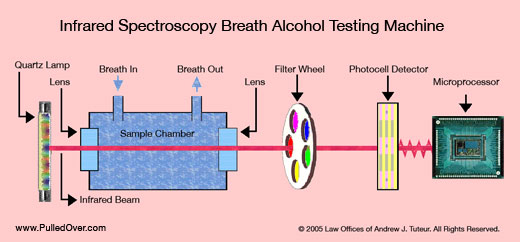Missouri's implied consent law provides that any person who operates a motor vehicle in Missouri is deemed to have given consent to a chemical test or tests of the person's breath, blood, saliva or urine for the purpose of determining the alcohol or drug content of the person's blood when arrested for driving while intoxicated (DWI).
The Intoxilyzer 5000 (CMI, Inc.) and the DataMaster (National Patent Analytical Systems, Inc.) breath alcohol testing machines are used in Missouri.
This page provides information and links relating to the law and science of the infrared spectrometry / spectroscopy breath alcohol testing machines used in Missouri.
MODWI.com | MO DWI / DUI Defense Attorneys | Suspensions | Revocations
Click Here for a FREE Consultation with a MO DUI / DWI defense attorney.
Breath Alcohol Testing in Missouri
Law and Science
Introduction
The Law
Missouri's implied consent law provides that any person who operates a motor vehicle in Missouri is deemed to have given consent to a chemical test or tests of the person's breath, blood, saliva or urine for the purpose of determining the alcohol or drug content of the person's blood when arrested for driving while intoxicated (DWI).
Refusal to Submit to a Breath Alcohol Test
If a person arrested for DWI refuses to submit to a breath alcohol test upon the request of the officer, then the person's license shall be immediately revoked and evidence of the refusal shall be admissible in a criminal proceeding against the person for driving while intoxicated (RSMo 577.010, DWI) or driving with excessive blood alcohol content (RSMo 577.012, BAC). immediately revoked upon refusal to take the test.
Initial notice of the refusal should be served on the driver by the arresting officer. The officer completes and sends information to the Department of Revenue using an Alcohol Influence Report form or a Refusal Affidavit. The arresting officer will take possession of any valid Missouri Driver License the driver has in his or her possession and issue a 15 day permit. Any continued driving beyond the initial 15 day period must be pursuant to a court issued stay order. The stay order will hold the revocation in abeyance until disposition of the case.
The lawyers at MODWI.com handle cases where our client has been issued a 15 day permit and refusal notice. We file a lawsuit on behalf of our client against the Department of Revenue. The lawsuit commonly is known as a "Petition for Review" because the purpose of the lawsuit is to "petition" the Court to "review" the license revocation. When the lawsuit is filed, a Stay Order may be issued so our client, the petitioning driver, may drive legally while the lawsuit is is pending. The ultimate goal of the lawsuit is for the Court to enter an Order to quash and set aside the revocation and have any record of the revocation removed from the driver's record.
Admissibility of Breath Alcohol Testing at Trial
When a driver arrested for DWI does submit to a chemical test of The amount of alcohol in the person's blood at the time of the act alleged as shown by any chemical analysis of the person's breath is admissible into evidence at trial. If a breath alcohol test of the person's blood showed that there was eight-hundredths of one percent or more by weight of alcohol in the person's blood, this shall be prima facie evidence that the person was intoxicated at the time the specimen was taken. (RSMo 577.037)
The Science
The Intoxilyzer 5000 (CMI, Inc.) and the DataMaster (National Patent Analytical Systems, Inc.) breath alcohol testing machines are used in Missouri. Both machines use Infrared Spectrometry / Spectroscopy (IR) to measure breath alcohol. The basic premise underlying IR is that every gas molecule will absorb energy in the form of electromagnetic radiation at a unique and specific wavelength. The pattern of absorption thereby creates a "fingerprint" (most commonly expressed in percent transmittance) by which that molecule may be identified. Using IR, the machines are designed to identify the presence and concentration of ethanol in a breath sample.
There are several steps involved in these machines using IR to determine blood alcohol concentration. First, a quartz lamp generates infrared (IR) light. The IR light travels through a chamber containing the breath sample. After passing through the chamber, the light travels through narrowband infrared filters and is focused on a photo detector. The photo detector converts the IR light pulses into electrical pulses which a fed into a microprocessor. The microprocessor uses a pre-programmed formula to "interpret" the electrical pulses and derive a number representing the "Blood Alcohol Concentration" which then is displayed.

MODWI.com | Missouri DWI / DUI Drunk Driving Defense Lawyers | MIP | Criminal and Traffic Law
MODWI.com | Missouri DWI / DUI Drunk Driving Defense Lawyers | MIP | Criminal and Traffic Law
